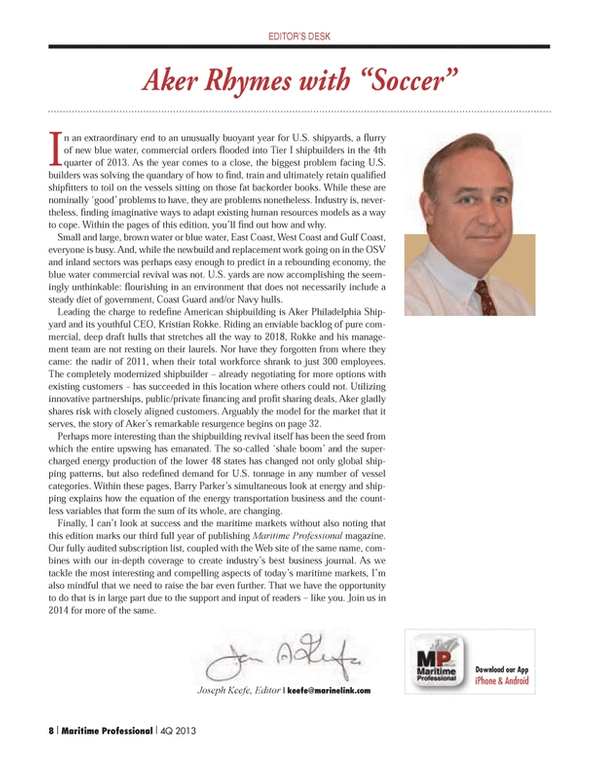
Aker Rhymes with “Soccer”
In an extraordinary end to an unusually buoyant year for U.S. shipyards, a flurry of new blue water, commercial orders flooded into Tier I shipbuilders in the fourth quarter of 2013. As the year comes to a close, the biggest problem facing U.S. builders was solving the quandary of how to find, train and ultimately retain qualified shipfitters to toil on the vessels sitting on those fat backorder books. While these are nominally ‘good’ problems to have, they are problems nonetheless. Industry is, nevertheless, finding imaginative ways to adapt existing human resources models as a way to cope. Within the pages of this edition, you’ll find out how and why.
Small and large, brown water or blue water, East Coast, West Coast and Gulf Coast, everyone is busy. And, while the newbuild and replacement work going on in the OSV and inland sectors was perhaps easy enough to predict in a rebounding economy, the blue water commercial revival was not. U.S. yards are now accomplishing the seemingly unthinkable: flourishing in an environment that does not necessarily include a steady diet of government, Coast Guard and/or Navy hulls.
Leading the charge to redefine American shipbuilding is Aker Philadelphia Shipyard and its youthful CEO, Kristian Rokke. Riding an enviable backlog of pure commercial, deep draft hulls that stretches all the way to 2018, Rokke and his management team are not resting on their laurels. Nor have they forgotten from where they came: the nadir of 2011, when their total workforce shrank to just 300 employees. The completely modernized shipbuilder – already negotiating for more options with existing customers – has succeeded in this location where others could not. Utilizing innovative partnerships, public/private financing and profit sharing deals, Aker gladly shares risk with closely aligned customers. Arguably the model for the market that it serves, the story of Aker’s remarkable resurgence begins on page 32.
Perhaps more interesting than the shipbuilding revival itself has been the seed from which the entire upswing has emanated. The so-called ‘shale boom’ and the supercharged energy production of the lower 48 states has changed not only global shipping patterns, but also redefined demand for U.S. tonnage in any number of vessel categories. Within these pages, Barry Parker’s simultaneous look at energy and shipping explains how the equation of the energy transportation business and the countless variables that form the sum of its whole, are changing.
Finally, I can’t look at success and the maritime markets without also noting that this edition marks our third full year of publishing Maritime Professional magazine. Our fully audited subscription list, coupled with the Web site of the same name, combines with our in-depth coverage to create industry’s best business journal. As we tackle the most interesting and compelling aspects of today’s maritime markets, I’m also mindful that we need to raise the bar even further. That we have the opportunity to do that is in large part due to the support and input of readers – like you. Join us in 2014 for more of the same.
(As published in the 4Q edition of Maritime Professional - www.maritimeprofessional.com)
Read Aker Rhymes with “Soccer” in Pdf, Flash or Html5 edition of Q4 2013 Maritime Logistics Professional
Other stories from Q4 2013 issue
Content
- Aker Rhymes with “Soccer” page: 8
- Changes in Oil Trade Patterns and their Effects page: 10
- Maritime M&A: Financial Crisis to Present Day page: 16
- When is a Ship Not a Ship? page: 18
- NASSCO’s Parker Larson on All Things Shipbuilding page: 20
- Beyond Shipbuilding: Training and Recruitment page: 24
- The Aker Way: From Surviving to Thriving page: 32
- Converting for the Oil Market page: 40
- Damen Looks Offshore page: 43
- 3D Laser Scanning for the Marine Industry page: 46
- Technology Answers Risk and Security Questions page: 49
- Setting Standards for Maritime Security page: 52
- New Ballast Water Management Regulations page: 54


